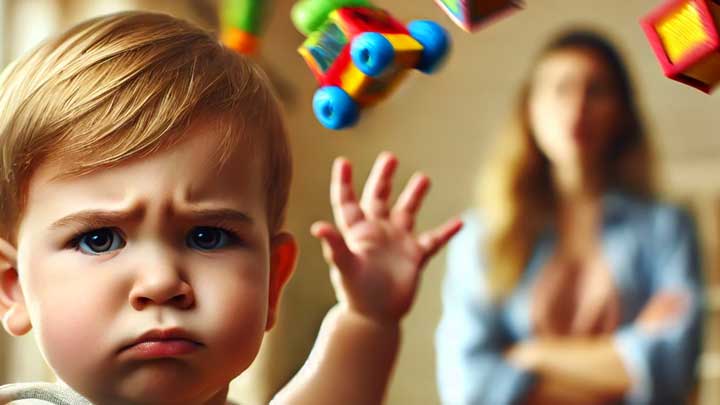Home > Online Counselling > Kid’s Problems > Toddler Throwing Things

You’re in the living room. Your toddler is holding a block. You turn your head for a second—and suddenly, that block is flying across the room, bouncing off the couch or smacking the dog’s tail. You let out a sigh, maybe a scold. And it keeps happening.
Sound familiar? You’re not alone.
This isn’t every moment of the day. It’s not every single object. But it’s often enough that you’re starting to wonder: is this normal? Is this aggression? Am I missing something? Or worse—am I doing something wrong?
As a child counselor and parenting strategist, let me tell you: this phase is common. But it’s not random, and it’s not meaningless. Throwing behaviors in toddlers are little windows into their inner worlds—needs, frustration, curiosity, or simply the joy of “what happens if I do this?”
This article will help you understand why your toddler throws, what it means, when it might be a red flag—and most importantly, how you can guide them through this without yelling, over-correcting, or shutting down curiosity.
Absolutely. In fact, it’s so common that it has its own spot in developmental play checklists.
Throwing objects is part of the toddler’s natural motor development and exploratory behavior. Around 12 to 24 months, children discover that not only can their hands grasp things—but those things can move in space. Quickly. Noisily. And sometimes… hilariously.
Studies show that over 70% of toddlers throw objects occasionally by 18 months. By two years old, it’s one of their favorite cause-and-effect games: “What happens if I throw this cup? This spoon? This toy? Oh, mom reacts!”
But it’s not always playful. Some kids throw when they’re tired. Others throw when they’re angry. And for some, it’s their way of communicating “I’m done,” “I’m overwhelmed,” or “I want attention.”
The frequency and intensity vary child by child. It becomes a concern when:
Even in those situations, it’s rarely about “being bad.” It’s about being young—and still learning what to do with big emotions and little hands.
Throwing isn’t always about misbehavior. It’s often a cocktail of development, curiosity, environment, and emotion. Here are the most common root causes:
Knowing the “why” behind the throw helps shift your reaction from frustration to guidance.
While it starts as playful or emotional expression, unchecked throwing can lead to bigger problems—not because the act itself is bad, but because it can morph into more serious behavior patterns.
This doesn’t mean every throw is a warning sign—but repeated, emotionally-charged throwing needs a response that teaches, not punishes.
Let’s talk strategy—not just discipline. Because honestly, this isn’t about being “strict enough.” It’s about helping your child grow out of a behavior with tools, not fear.
And most importantly—don’t expect it to stop in a day. This is about rewiring habits, which takes weeks of gentle repetition.
If you’re not sure which strategy fits your child’s temperament, the LiveMIS Personality Report can help pinpoint what kind of emotional cues your child responds to best.
Every time your toddler throws, you’re not “failing.” You’re being handed a teaching moment.
Progress doesn’t look like perfection. It looks like fewer throws. Slower throws. A pause before the throw. A look of guilt after. These are the signs your child is learning.
Even famous innovators like Elon Musk were described as “intense” toddlers. What mattered most was that someone guided them, rather than punished them, through those years of intensity.
You’re not raising a robot. You’re raising a person who feels things deeply and expresses loudly—until they learn how to do it more wisely. And you’re the guide they need for that.
Before you book therapy or redesign your parenting plan from scratch, LiveMIS offers quick tools that give you insights in minutes:
It’s not magic—it’s psychology simplified, so you can parent with less stress and more confidence.
This phase? It’s real. It’s tiring. But it’s not permanent.
Throwing behavior can be a cry for help, a call for fun, or a spark of curiosity. Your job isn’t to shut it down—it’s to decode it, respond to it, and gently redirect it until your child has the tools to manage themselves better.
You’ve got what it takes. And with the help of LiveMIS insights, you won’t just be reacting—you’ll be parenting with foresight, confidence, and calm.
